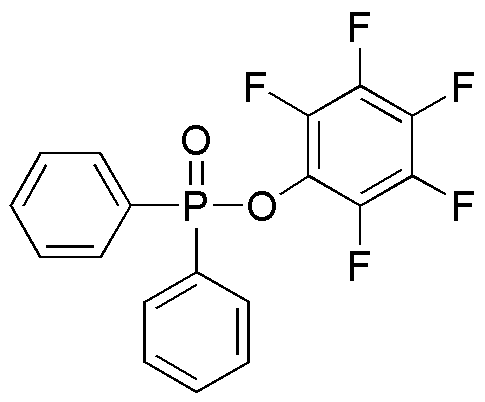Pentafluorophenyl diphenylphosphinate is widely utilized in research focused on:
- Fluorinated Polymer Synthesis: This compound serves as a valuable reagent in the production of fluorinated polymers, which are known for their chemical resistance and thermal stability, making them ideal for high-performance applications in industries such as aerospace and electronics.
- Pharmaceutical Development: It is used in the synthesis of various pharmaceutical intermediates, enhancing the efficiency of drug formulation processes and improving the bioavailability of active compounds.
- Analytical Chemistry: The compound acts as a derivatizing agent in analytical methods, aiding in the detection and quantification of specific analytes in complex mixtures, which is crucial for quality control in food and environmental testing.
- Fluorine Chemistry Research: Researchers leverage its unique properties to explore new fluorinated compounds, contributing to advancements in materials science and catalysis, which can lead to innovative solutions in energy storage and conversion.
- Surface Modification: It is employed in surface treatment processes to enhance the hydrophobicity and chemical stability of various materials, benefiting industries such as textiles and coatings.
General Information
Properties
Safety and Regulations
Applications
Pentafluorophenyl diphenylphosphinate is widely utilized in research focused on:
- Fluorinated Polymer Synthesis: This compound serves as a valuable reagent in the production of fluorinated polymers, which are known for their chemical resistance and thermal stability, making them ideal for high-performance applications in industries such as aerospace and electronics.
- Pharmaceutical Development: It is used in the synthesis of various pharmaceutical intermediates, enhancing the efficiency of drug formulation processes and improving the bioavailability of active compounds.
- Analytical Chemistry: The compound acts as a derivatizing agent in analytical methods, aiding in the detection and quantification of specific analytes in complex mixtures, which is crucial for quality control in food and environmental testing.
- Fluorine Chemistry Research: Researchers leverage its unique properties to explore new fluorinated compounds, contributing to advancements in materials science and catalysis, which can lead to innovative solutions in energy storage and conversion.
- Surface Modification: It is employed in surface treatment processes to enhance the hydrophobicity and chemical stability of various materials, benefiting industries such as textiles and coatings.
Documents
Safety Data Sheets (SDS)
The SDS provides comprehensive safety information on handling, storage, and disposal of the product.
Product Specification (PS)
The PS provides a comprehensive breakdown of the product’s properties, including chemical composition, physical state, purity, and storage requirements. It also details acceptable quality ranges and the product's intended applications.
Certificates of Analysis (COA)
Search for Certificates of Analysis (COA) by entering the products Lot Number. Lot and Batch Numbers can be found on a product’s label following the words ‘Lot’ or ‘Batch’.
*Catalog Number
*Lot Number
Certificates Of Origin (COO)
This COO confirms the country where the product was manufactured, and also details the materials and components used in it and whether it is derived from natural, synthetic, or other specific sources. This certificate may be required for customs, trade, and regulatory compliance.
*Catalog Number
*Lot Number
Safety Data Sheets (SDS)
The SDS provides comprehensive safety information on handling, storage, and disposal of the product.
DownloadProduct Specification (PS)
The PS provides a comprehensive breakdown of the product’s properties, including chemical composition, physical state, purity, and storage requirements. It also details acceptable quality ranges and the product's intended applications.
DownloadCertificates of Analysis (COA)
Search for Certificates of Analysis (COA) by entering the products Lot Number. Lot and Batch Numbers can be found on a product’s label following the words ‘Lot’ or ‘Batch’.
*Catalog Number
*Lot Number
Certificates Of Origin (COO)
This COO confirms the country where the product was manufactured, and also details the materials and components used in it and whether it is derived from natural, synthetic, or other specific sources. This certificate may be required for customs, trade, and regulatory compliance.


